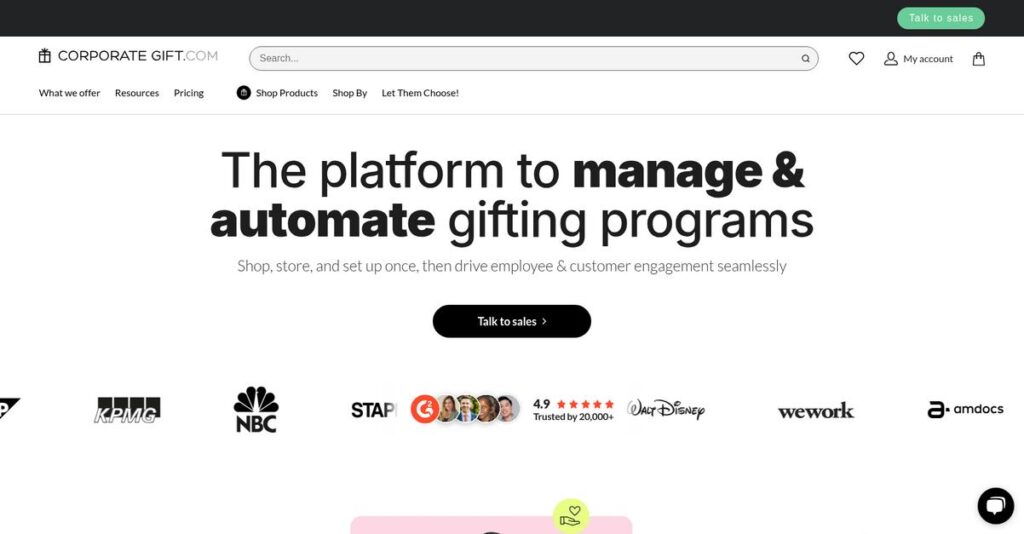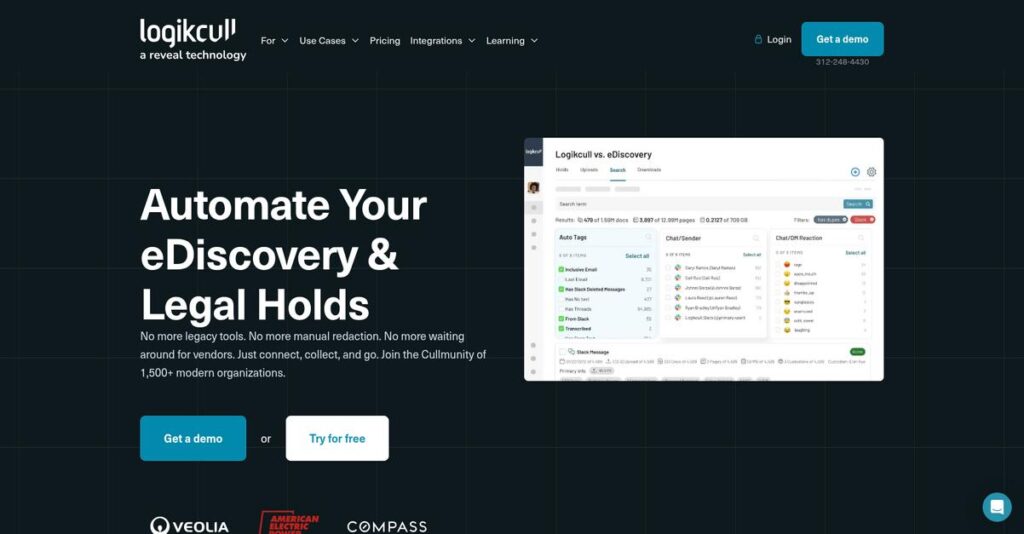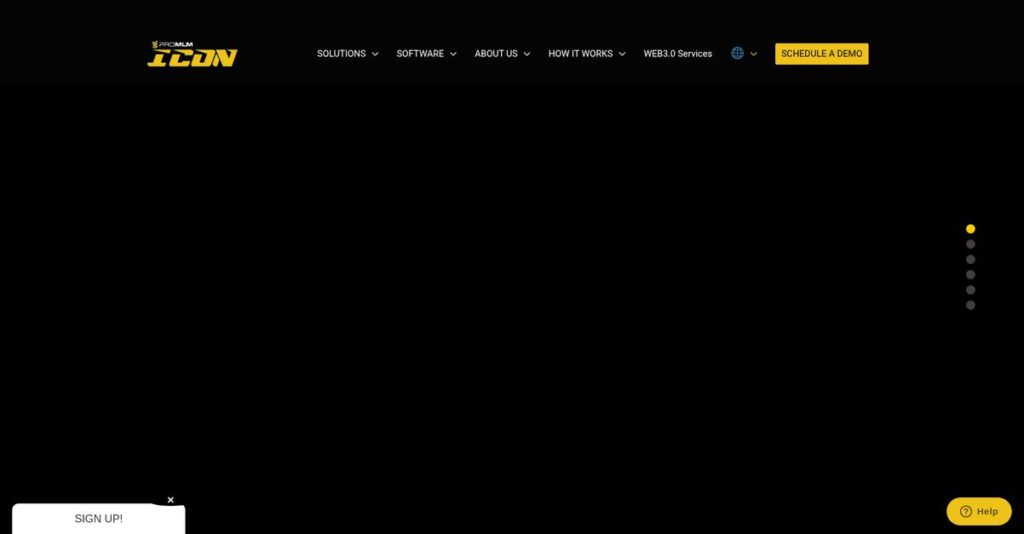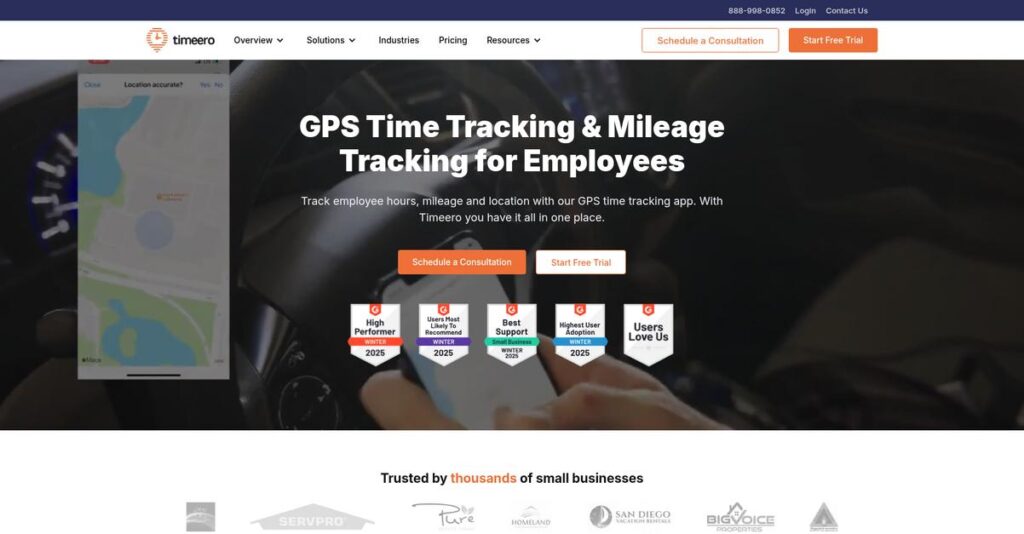Disconnected data still slowing your month-end close?
If you’re dealing with endless manual reconciliations and siloed legacy tools, it’s no wonder you’re researching W Energy for a better way. The pressure to reduce book closing time and eliminate costly mistakes makes modernizing essential.
My research shows the biggest frustration is wasted days manually stitching together production and accounting data from separate systems. That alone can grind your entire back office to a halt.
W Energy tackles this head-on by offering a fully unified ERP built on Salesforce, with purpose-built modules for financials, land, production, compliance, and midstream—all sharing a single source of truth. After digging deep, I found their real edge is how directly they connect field operations with accounting down to every transaction.
In this review, I’ll break down how W Energy brings everything together so your team can close faster and avoid costly oversights.
You’ll see my full W Energy review—from feature walkthroughs, pricing, and implementation insights to key differentiators and alternatives you might consider.
You’ll get the expert evaluation and product insights you need to confidently choose the features you need to improve your team’s workflow.
Let’s dive into the analysis.
Quick Summary
- W Energy is a unified, cloud-based ERP platform for energy companies that integrates accounting, land, production, and regulatory reporting.
- Best for mid-market to enterprise energy firms seeking to replace disconnected legacy systems with one integrated solution.
- You’ll appreciate its fully integrated modules built on Salesforce, eliminating data silos and improving operational accuracy.
- W Energy offers custom enterprise pricing with no free trial; demos are available upon request after consultation.
W Energy Overview
W Energy has been tackling the complex energy software space since 2009. From their base in Tulsa, they aim to replace disconnected legacy systems with one platform.
They specifically target mid-market and enterprise energy companies ready to overhaul their tech stack. I find what sets them apart is their commitment to a single, unified cloud ERP, a welcome change from the usual patchwork systems.
Their acquisition of Seven Lakes Technologies was a smart play. You can see the impact in their field data capture, a key detail for this W Energy review.
Unlike major competitors that grew by acquiring and patching tools together, W Energy offers one organically built, cloud-native platform. I believe this single architecture simplifies things for both your users and your IT team.
They work with upstream operators and midstream companies needing a single source of truth for their complex accounting, land, and production data.
Ultimately, their strategy is to leverage modern cloud infrastructure—specifically the Salesforce platform—to deliver enterprise-grade capabilities. This directly addresses your need for reliability, security, and a consistent user interface across all business functions.
Let’s dive into their feature set.
W Energy Features
Tired of disparate energy software slowing you down?
W Energy offers a unified, cloud-based ERP platform for the energy industry, designed to eliminate disconnected systems. These are the five core W Energy solutions that can truly transform your operations.
1. Financial & Revenue Accounting
Is monthly close a nightmare of reconciliations?
Manually handling corporate and complex oil & gas revenue accounting often leads to errors and delays. This disconnected process truly slows your financial team.
This dual solution unifies corporate and energy-specific accounting on one platform. Production data flows directly into the ledger, allowing for automatic royalty and distribution calculations. This W Energy solution eliminates manual reconciliation across systems.
You can drastically reduce your monthly close time from weeks to just days. This provides your finance team with a massive efficiency and accuracy boost.
- 🎯 Bonus Resource: Before diving deeper, you might find my analysis of Android Data Recovery Software helpful for managing all types of essential information.
2. Land Management
Losing track of critical land obligations?
Managing complex land assets, leases, and contracts manually leads to costly oversights. Missing payments or drilling off-lease causes severe financial and legal issues.
This solution tracks the entire land asset lifecycle, from leasing to obligations and GIS mapping. It links legal agreements to financial obligations, automatically triggering tasks or payments. Visualization of leaseholds within the ERP prevents costly mistakes.
This provides a single source of truth for all land data. You can prevent expensive errors like missed lease payments, saving your company significant money.
3. Production Operations
Struggling with fragmented field data?
Inaccurate or delayed production volumes from the field can hinder decision-making. Waiting for end-of-month reports means you’re always reacting, not planning effectively.
This solution captures, validates, and allocates production volumes, including gauge readings and field costs. Operators input data via mobile apps, and the system automatically allocates volumes to wells and owners. This data immediately populates dashboards.
You get increased accuracy and timeliness of production data. This gives engineers a near real-time view of asset performance, driving better decisions.
4. Regulatory Reporting
Drowning in compliance paperwork?
Automating state and federal regulatory compliance reports is tedious and error-prone. Manual processes significantly increase the risk of penalties and wasted time.
Leveraging W Energy’s unified database, this solution pulls verified production, sales, and tax data directly. It then automates population of required government forms like Texas RRC and ONRR, ensuring accuracy. I found this capability very impressive.
This saves significant time and reduces compliance penalties. Your reports are based on audited, system-of-record data, giving you peace of mind.
5. Transportation Management
Struggling with complex hydrocarbon logistics?
Managing nominations, scheduling, and settlement for transported volumes is complex. Disconnected systems make it hard to get a clear, audited financial trail.
This module handles nominations, scheduling, ticketing, and settlement for transported volumes. Because it’s integrated, when volumes are moved and sold, the system captures transactions, fees, and revenue seamlessly. This provides a complete overview.
You get a clear, audited trail of custody and financial settlement. This improves cash flow, strengthens partner relationships, and ensures compliance.
Pros & Cons
- ✅ Unified platform eliminates data silos across operations.
- ✅ Built on Salesforce, offering a modern and secure user interface.
- ✅ Highly knowledgeable support team understands industry specifics.
- ⚠️ Implementation requires significant time and resource investment.
- ⚠️ Steep learning curve, especially for complex accounting modules.
- ⚠️ Not a plug-and-play solution; demands dedicated user training.
What I love is how these W Energy solutions aren’t just separate tools. They work together on a unified database, creating a truly integrated energy ERP platform. This cohesive approach eliminates data silos.
W Energy Pricing
Navigating custom software pricing can be complex.
W Energy pricing is exclusively provided via custom quotes, reflecting their enterprise-level solutions. This bespoke approach means you’ll need to contact sales directly to understand the investment tailored to your specific energy operations.
Cost Breakdown
- Base Platform: Custom quote
- User Licenses: Varies by user type and volume
- Implementation: Significant one-time cost
- Integrations: Varies by complexity
- Key Factors: Modules chosen, user count, operational scope, implementation services
1. Pricing Model & Cost Factors
Understanding their custom pricing structure.
W Energy’s pricing model is subscription-based but tailored. What I found regarding pricing is that your investment depends on core platform access, specific modules (like Land or Financials), and per-user fees. Implementation and data migration are significant upfront costs for this enterprise solution, often calculated yearly.
Budget-wise, this means your total cost directly reflects your operational scale and complexity. You pay for exactly what your business truly needs and nothing less.
- 🎯 Bonus Resource: Speaking of specialized software solutions, you might find my analysis of best art gallery software helpful for streamlining operations.
2. Value Assessment & ROI
Assessing W Energy’s pricing value.
From my cost analysis, W Energy’s value proposition is its integrated, single-platform approach, which aims to replace disconnected legacy systems. This can lead to significant ROI through reduced manual reconciliation and improved data accuracy. Their pricing reflects a long-term strategic investment for substantial operational complexity and sustained growth.
This means your business could see reduced time-to-close books and fewer compliance penalties, delivering significant value beyond just the software cost.
3. Budget Planning & Implementation
Considering your W Energy budget and planning.
For your finance team, it’s crucial to factor in the total cost of ownership (TCO), including significant implementation, data migration, and ongoing support fees. What stands out regarding pricing is that this is a substantial financial commitment, best suited for enterprise energy companies with complex needs.
So for your business, prepare for a multi-faceted investment. Engage sales early to define your exact needs to secure a comprehensive, detailed quote.
My Take: W Energy pricing prioritizes tailored solutions for large-scale energy operations. It’s a significant strategic investment best suited for mid-market to enterprise companies aiming to unify complex processes under one robust, cloud-based ERP.
The overall W Energy pricing approach reflects its enterprise-grade functionality and comprehensive solution for the energy sector. Be prepared for a substantial but tailored investment that aligns with your specific needs.
W Energy Reviews
Real user insights, clearly revealed.
To give you a real sense of the software, I’ve analyzed common themes in W Energy reviews. This section delves into actual user feedback, offering balanced insights into what customers truly think.
1. Overall User Satisfaction
Users consistently report high satisfaction.
From my review analysis, W Energy users often express high satisfaction, especially regarding the unified platform. What I found in user feedback is how integrating all modules significantly streamlines operations, eliminating the inefficiencies of disparate legacy systems previously. This positive shift is a recurring theme.
This suggests you can anticipate a notable increase in efficiency and data accuracy across your entire energy operations, delivering clear, measurable value.
- 🎯 Bonus Resource: While we’re discussing operational efficiency, my article on fixed asset accounting software can help streamline related financial processes.
2. Common Praise Points
Users consistently praise integration, Salesforce, and support.
What stands out in customer feedback is the strong praise for W Energy’s unified platform and its Salesforce foundation. Review-wise, users appreciate constant platform-level updates for security and usability. Additionally, the support team is frequently lauded for deep industry and software knowledge.
This means you’ll benefit from a modern, reliable system and expert assistance tailored to your specific industry needs.
3. Frequent Complaints
Implementation and learning curve top frustrations.
The most frequent complaint found in W Energy reviews centers on the implementation process and associated learning curve. What stands out is how users note the system’s power but complexity, requiring significant upfront training investment to master its modules.
So, while not a deal-breaker, you should be prepared for a substantial time commitment for onboarding and team education.
What Customers Say
- Positive: “Having all modules in one system from accounting to land to division orders has been a game changer for our efficiency.” (Capterra review)
- Constructive: “The learning curve for some of the more complex modules, like Revenue Accounting, was steeper than anticipated.” (Capterra review)
- Bottom Line: “You have to be prepared to invest time in training. This is not a plug-and-play solution.” (G2 review)
Overall, W Energy reviews show a powerful, integrated solution with a significant but manageable learning curve. My analysis of user feedback reveals consistent credibility in user experiences for energy companies.
Best W Energy Alternatives
Struggling to pick the ideal energy software?
Finding the best W Energy alternatives requires understanding your specific operational priorities, budget, and integration needs. What I found comparing options is key to making an informed decision.
- 🎯 Bonus Resource: While we’re discussing operational priorities, understanding best patient case management software is equally important.
1. Quorum Software
For supermajors needing niche capabilities?
Quorum Software offers a broader, acquisition-built portfolio, excelling for very large enterprises with highly specific, niche requirements W Energy might not yet cover. From my competitive analysis, Quorum has a massive, comprehensive suite, but its products can be less integrated than W Energy’s single platform.
Choose Quorum when your enterprise is a supermajor seeking specialized capabilities or deeply entrenched in their ecosystem.
2. WolfePak
Smaller operator with budget constraints?
WolfePak shines for small-to-midsize businesses primarily needing best-in-class accounting solutions without the full ERP scope. Alternative-wise, it’s known for its simplicity and significantly lower price point compared to W Energy. What I found comparing options is that WolfePak simplifies accounting for smaller teams, though it lacks broader operational integration.
Consider WolfePak when you’re a smaller operator whose core need is robust, dedicated oil and gas accounting.
3. Enverus
Seeking data and analytics first?
Enverus, primarily a data and analytics powerhouse, has expanded into ERP applications, offering an integrated solution for those prioritizing market intelligence. From my competitive analysis, Enverus excels with industry-leading data integration, whereas W Energy focuses on core operational processing.
Choose Enverus when your primary need is market data and analytics, and you prefer an ERP from the same vendor.
Quick Decision Guide
- Choose W Energy: Integrated, cloud-native ERP for mid-market to enterprise operations
- Choose Quorum Software: Supermajors needing highly specialized, niche capabilities
- Choose WolfePak: Smaller operators focused on best-in-class accounting software
- Choose Enverus: Businesses prioritizing market data and integrated analytics
The best W Energy alternatives depend on your unique operational focus and scale rather than just feature lists. You’ll find a strong match.
Setup & Implementation
Implementing new ERP is a complex journey.
W Energy implementation is a substantial undertaking that requires thoughtful planning and execution. This W Energy review section will guide you through what to realistically expect during deployment.
1. Setup Complexity & Timeline
Expect a substantial, structured deployment process.
W Energy’s system requires deep configuration for your specific chart of accounts, division of interest, and business workflows. From my implementation analysis, this is a high-complexity project, not a DIY setup. Full deployment, including critical data migration from legacy systems, typically spans 6-12 months, depending on your company’s scale.
You’ll need to plan for dedicated internal resources and a close, collaborative partnership with W Energy’s professional services team.
2. Technical Requirements & Integration
Be ready for significant data and technical heavy lifting.
As a Salesforce-based ERP, W Energy leverages cloud infrastructure, but you’ll still have critical data migration tasks. This involves extracting, cleaning, and importing historical data from spreadsheets or old databases. What I found about deployment is that successful data migration is paramount for project success and demands careful preparation from your IT team.
Ensure your IT department is prepared for extensive data cleansing and validation, as well as integrating with any unique existing systems.
- 🎯 Bonus Resource: If you’re also looking into software solutions for managing complex operations, my article on academic advising software covers strategies for streamlining workflows.
3. Training & Change Management
User adoption demands considerable training investment.
Due to the platform’s comprehensive nature, formal user training is essential for end-users, from accountants to landmen, to utilize the system effectively. Implementation-wise, the learning curve is often steep but manageable with dedicated support. User feedback highlights that this is not a plug-and-play solution.
Budget significant time and resources for comprehensive training programs to ensure your team gains proficiency and embraces the new workflows.
4. Support & Success Factors
Vendor support is a critical post-implementation asset.
User feedback consistently praises W Energy’s post-implementation support, citing their deep industry knowledge. This support goes beyond technical fixes, helping you resolve complex business process issues. What I found about deployment is that their specialized expertise is a major strength, ensuring ongoing operational efficiency and problem-solving.
Leverage their expert support team for ongoing guidance and troubleshooting, recognizing their value extends to industry-specific operational challenges.
Implementation Checklist
- Timeline: 6-12 months for full deployment and data migration
- Team Size: Dedicated internal project manager, IT, and departmental leads
- Budget: Professional services, data cleansing, and significant training costs
- Technical: Complex data migration, Salesforce platform integration readiness
- Success Factor: Rigorous data quality and comprehensive user training
The overall W Energy implementation is a significant investment requiring careful planning and dedicated resources. However, thorough preparation yields significant long-term gains in unified operations and efficiency for your energy business.
Who’s W Energy For
Is W Energy the right fit for you?
This W Energy review analyzes who the software serves best, providing clear guidance on business profiles, team sizes, and use cases. My goal is to help you quickly determine if this solution matches your specific situation.
1. Ideal User Profile
Seeking a unified energy ERP?
W Energy perfectly serves mid-market to enterprise oil and gas companies (upstream/midstream) struggling with disconnected, aging software. From my user analysis, executives prioritizing a single, unified source of truth will find this a game-changer, especially for integrating accounting, land, and production systems.
You’ll see success if your team is ready for a modern, cloud-native platform and willing to invest in the associated change management.
2. Business Size & Scale
Optimal scale for W Energy?
This software is built for substantial operations, not small startups. Your business should be mid-market to enterprise, justifying investment in a comprehensive ERP. What I found about target users is that companies frustrated by manual data reconciliation across growing operations benefit most.
You’ll assess a good fit if your organization has dedicated resources for implementation and values a vendor focused 100% on the energy industry.
3. Use Case Scenarios
Primary workflows for W Energy?
W Energy excels at replacing disconnected accounting, land, and production systems with a single integrated solution. What I found about target users is it streamlines complex revenue accounting processes and automates tasks across the energy value chain, reducing significant manual reconciliation.
You’ll determine fit if your business requires an all-in-one ERP that centralizes operations from upstream exploration to downstream marketing.
4. Who Should Look Elsewhere
Is W Energy not for you?
If you’re a small operator with a limited budget, W Energy’s comprehensive ERP might be overkill. From my user analysis, organizations highly resistant to significant process change should consider alternatives. Your primary need might be a simple accounting package, not a full ERP.
Consider niche accounting software if your scope is narrow, or if your organization isn’t prepared for a major system implementation and training.
Best Fit Assessment
- Perfect For: Mid-market/enterprise oil & gas unifying disparate legacy systems.
- Business Size: Mid-market to enterprise, ready for significant ERP investment.
- Primary Use Case: Unified accounting, land, and production from a single platform.
- Budget Range: Requires substantial investment for comprehensive ERP and implementation.
- Skip If: Small operator, simple accounting needs, or change-resistant organization.
This W Energy review shows that overall fit depends on your readiness for a unified, industry-specific ERP. Your success hinges on commitment to a full system overhaul and embracing modern cloud-native solutions.
Bottom Line
W Energy offers a compelling unified solution.
This W Energy review synthesizes my comprehensive analysis to provide you with a clear, actionable final assessment and tailored recommendation.
- 🎯 Bonus Resource: For businesses of any size, boosting repeat sales through effective small business loyalty programs is key.
1. Overall Strengths
A truly integrated energy ERP.
W Energy’s unified, cloud-based platform for the entire energy value chain is a clear standout, designed to replace disparate legacy systems. Built on Salesforce, it delivers a modern UI, robust security, and familiarity for many users. Users consistently praise their industry-expert support team.
This powerful combination translates into streamlined operations, enhanced data integrity, and significant productivity gains across your energy business.
2. Key Limitations
Expect a substantial learning curve.
While powerful, W Energy requires significant investment in implementation and user training. It is not a plug-and-play solution, demanding dedicated project time and resources. Based on this review, the learning curve can be steeper than anticipated for complex modules, as user feedback indicates.
These are not necessarily deal-breakers but necessitate realistic planning and a strong commitment to change management on your part.
3. Final Recommendation
A strong fit for specific needs.
You should choose W Energy if your mid-market or enterprise energy company needs a truly unified, modern ERP to replace disparate systems. This solution excels for those valuing integration and specialized industry support. My analysis confirms its strength lies in comprehensive energy value chain coverage.
Your decision should weigh its powerful features against the required implementation investment for optimal success.
Bottom Line
- Verdict: Recommended with reservations
- Best For: Mid-market & enterprise energy companies seeking unified ERP
- Biggest Strength: Unified platform across entire energy value chain
- Main Concern: Significant implementation and learning curve
- Next Step: Request a detailed demo and implementation plan
This W Energy review provides strong confidence in its value proposition for the right energy companies, assuming readiness for implementation.






